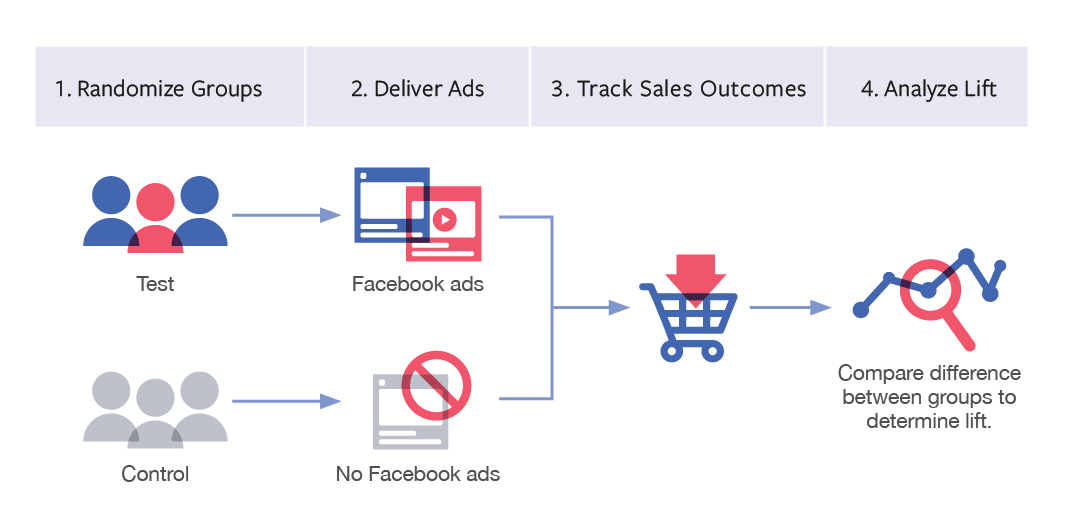By: Tom Murray | Managing Director
Facebook is often hailed for its ability to drive direct response, but it’s easy to forget that it can also be used for mass awareness and reach, as the largest social network with over 2.5 Billion people worldwide. And with over 85% of sales still occurring offline and not online, using Facebook to drive brand awareness and impact can be a very worthwhile endeavor.
The problem with these types of campaigns is that they are tough to measure. There is plenty of resource out there that shows that engagements and clicks do not correlate strongly to actual in-store purchase, which means a lot of the front end metrics such as impressions, video views, clicks, etc aren’t good indicators of performance. Sure, a bunch of people might have watched the video but it doesn’t mean they were moved enough to purchase.

These above metrics can only be measured through a Brand Lift study. Historically, these used to only be available through Nielsen, but then eventually Facebook offered their own study as well. These came with healthy spend minimums, typically at $175,000 media spend over a 1-3 month time frame at the absolute minimum, and the studies had to be set up and monitored by a Facebook partner or representative. They’ve since allowed for marketers to set up their own brand lift surveys in a self serve environment and lowered the minimum to $30,000 per test. This has lowered the barrier to entry, and all brands should be using brand lift surveys where possible to get directional information around how their ads are causing users to react.
In order to set up these tests, you need to just go into the test and learn section of Facebook, and you can set up Brand Lift surveys for active or upcoming campaigns. The requirements are simply as followed:
- You must spend at least $30,000 on the specific campaign (or across your account if you want to do the study across more than one campaign)
- The test must run for at least 14 days (though typically 30 days is recommended, and 90 days is the max)
- Ideally this would be on a new campaign and not something existing, as previous ads could impact the results (if a user in the new control group was already previous exposed to ads)
- Cannot be already running another test on the campaigns that are being chosen
- A holdout will be set-up; these users will be pulled from being targeted so that way Facebook can ask these users to get a baseline to compare against your exposed group

You also can select up to 3 questions, with the ad recall question (top left) being required. We typically recommend choosing ad recall, and then one of the mid funnel and one of the lower funnel questions to see if your campaign is having impact broadly, while also attempting to measure intent. Users will only receive one of the three questions in their feed, approximately two days after being exposed to an ad (if they are in the exposed group).

Our recommendation is to truly focus on moving ad recall, as that is the stat that is most correlated with actual in-store purchase. Facebook has done studies around this and found that ad recall is 4x more correlated to eventual in-store purchase than the question that actually asks if you will buy a specific product. This is counterintuitive at first glance, but since these ads are for branding and are meant to be something a user remembers to recall when they are at the shelf, it makes sense why ad recall is going to be the most important metric to move.

Once the test is over, you’ll receive results for each of your questions, understanding how the control responded against your exposed group who saw your ads. The goal is to have a higher delta from the control to the exposed, to show that the ads had impact. If Facebook gets enough responses, it can also report out on gender and age breakdowns as well for extra granularity. Here is a sample output of running a three question brand lift survey:

Brand lift surveys are an excellent way to test if your creative is resonating with users by seeing if a user can remember seeing an ad, or if they react positively to your brand. Views and clicks don’t have any correlation to the important brand metrics, so if you are reporting these metrics as ways to claim a campaign succeeded, as in saying a video achieved a higher view rate than benchmark or achieved a certain cost-per-view, look past that, as it is just noise. Control vs. exposed surveys are the easiest way to determine if your campaign had any chance of success at driving in-store sales or awareness.
